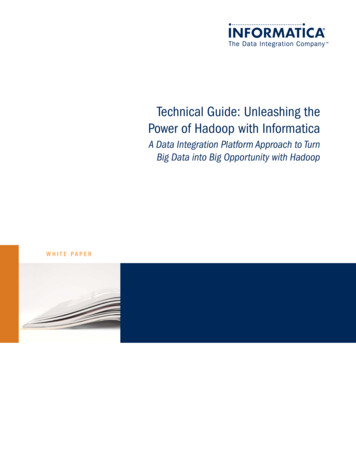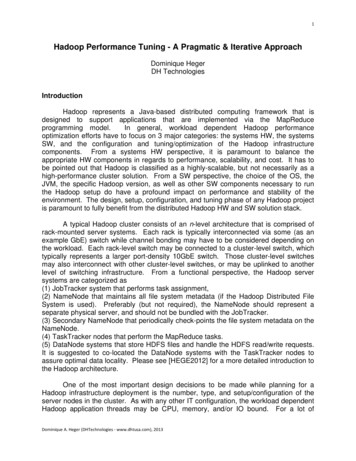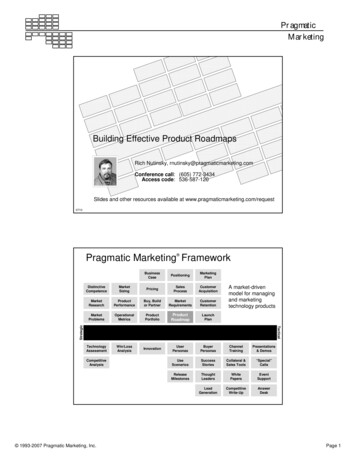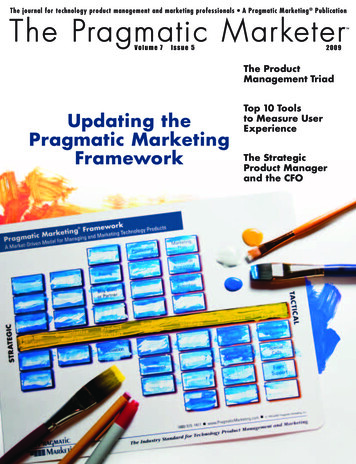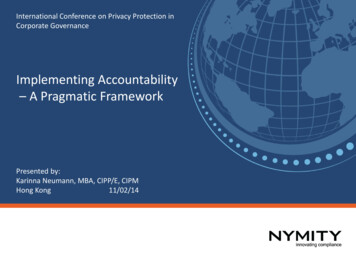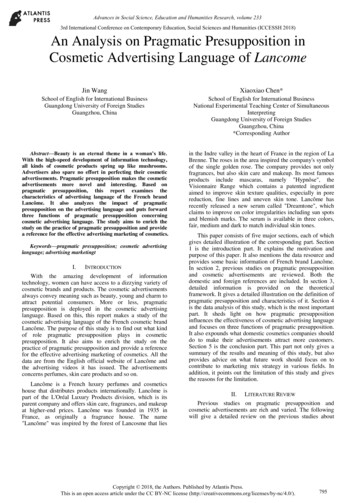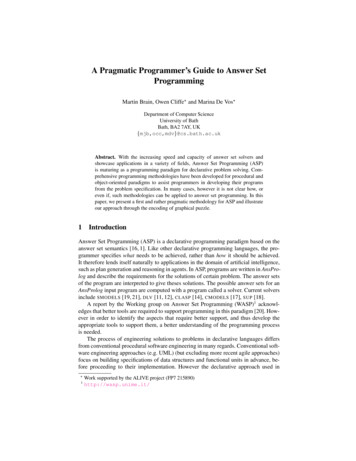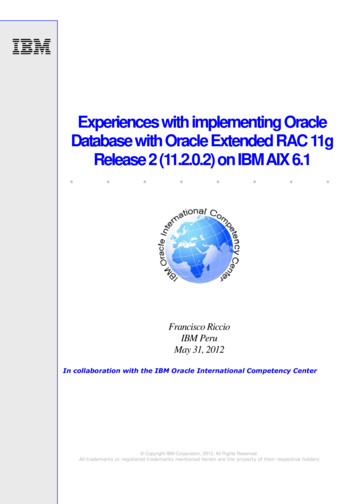
Transcription
Unleashing the pragmaticpower of the Lean StartupHow to directly implement the Lean Startup in practice: an extended modelby Hanneke Gieles
2
AbstractBefore investing large sums and amounts of time into new ideas, it is beneficial to prove firstthat there is indeed a demand for them in the market. Experimentation is a way to validatethe likelihood of success of a new product or service resulting from new ideas. Investors arescarce and demand a reduced risk of failure of their investments. This holds true for largecompanies, as well as for small startups.This paper introduces a practical extension of the original Lean Startup Model, bydistinguishing 4 sequential phases in experiments. Furthermore, it adds an enrichmentto the original model. For example, by overlaying specific methods, and by addingimplementation practices. These additions to the original Lean Startup model providepractical handles for direct implementation, with the aim to prevent bad (or overlyexpensive) investments. The goal of this paper is to unleash the full power of the LeanStartup method, by translating the original model to concrete and practical steps.Using the steps and practices of the model introduced in this paper, helps you to reduce therisk of failure directly. It serves as a practical toolbox that suggests tools for the differentphases of experiments and connects it to other relevant and already proven methods andtechniques.3
IntroductionThe current attention for the Lean Startup cannot be seen as a surprise. Organizations are searchingfor ways to innovate and experiment. Nowadays the speed of innovation is so high, that it does notmake sense to wait for customers to dream up innovative products and services by themselves.Instead, most organizations take initiative based on their own ideas and expectations for futureneeds and possible opportunities. It is, however, very hard to use traditional market researchapproaches on these ideas because it is unsure what the market is, where it is, and how big itis. Traditional market research would be too slow to create real and valuable data. With suchuncertainty, experimenting seems a much better and more effective and efficient solution. A goodstrategy is to build simple versions of a product and test it with real customers first, before investinglargely into further development. Based on real feedback, it becomes possible to change the productand test again. This (iterative) process can be repeated until the product sells well and continuousinvestments are only done when there is a proven business model (or even better: when a healthycash flow is already coming in).The goal of the Lean Startup method is all about learning how to build a business. In fact, that is thereal deliverable of the experiments: discovery of a working business model. Traditional managementusually ignores that learnings are a valid deliverable too. Therefore, we found a new managementapproach in the Lean Startup. A new approach that embraces uncertainty and tackles this withrigorous experimentation. Management is crucial to make this work in practice, because LeanStartup is a disciplined, measurement-based and hardworking approach.4
Extended Lean Startup modelThis paper looks at ways to practically implement the Lean Startup Model developed by Eric Ries1,by extending the original model. Giving it concrete and pragmatic steps. A short explanation of theoriginal model can be found in appendix A.The main contribution of the extension presented in this paper is that the steer-phase has been splitup into 4 separate phases, where each phase matches a phase in the experiment. Additionally, ourapproach extends the original model with practices and other methods. The references listed belowthe picture give an overview of the different sources of these practices and methods.The starting point is the vision and the Lean Startup Canvas (Appendix C) that represents the visionin a one-page format. The goal is to validate all parts of the canvas and, as shown in appendix B,each part of the canvas corresponds with one of the phases. The canvas is divided in three areas:market, product and customer. Each phase results into concrete verifications in all these three areasin order to move to the next phase. Our extension provides practical guidelines and actions to buildup the level of experimentation, and as such gives four separate phases of hypothesis-testing. Themain benefit of this is that the amount of investment and thus risk is reduced without major impacton speed, because each phase provides learning that accelerate subsequent phases.Understand ProblemDefine SolutionDesign ThinkingSteerValidate QualitativelyAccelerateValidate QuantitativelyLean UXGrowth HackingCustomer DiscoveryAgileCustomer ValidationCompany CreationCompany BuildingRiskAnalysis PriosVisionAbortDemo/MVPLeanCanvasesBLeap ataD2BDataProblem InterviewsFind Prospects3IdeaDataBIdeaM4ScaleJIT ScalabilityAdaptive OrganizationEngine of AbortSolution InterviewsQuantitative ValidationInnovation accountingAARRRMVP/UVPAbortStartupLQualitative ValidationMVP InterviewsAbortMarket ExpansionPMMeasureProblem - Market Fit 80% interviewsno new insightsProblem ValidationProblem - Solution Fit 80% interviewsno new insightsProblem ValidationProblem - Market Fit 80% conversionno Early AdoptersMarket ValidationBusiness Model FitSean Ellis Test 40% level 1Find external investorsMarket PenetrationReferenced practices and methods 1, 2, 3, 4, 5, 6, 7, 8, 9, 105
RiskAnalysis PriosVisionAbLLeanCanvasesLeap ofFaith1BLean Startup ModelMProblemhypothesis1. Problem validation2. Product validationIn this phase the Problem, CustomerSegments and Existing alternatives of thecanvas are validated. The goal is to establisha Product – Market fit by interviewingpotential customers. Only move to the nextphase, when being reasonably sure of havingdefined a significant problem in the market.A rule of thumb used often is that 80% of theinterviews give no new insights and confirmthe hypothesis on the canvas.In this phase the Solution, Early Adoptersand basic Revenue Streams parts of thecanvas are validated. The goal is to establisha Problem – Solution fit by building anMinimal Viable Product and keep improving itbased on customer feedback. Once the MVPmeets the predefined criteria for success, theexperiment can move to the next phase. Herethe same rule of thumb, regarding 80% of theinterviews confirming the canvas, could beused.Matching the appropriate methods andpractices to the different phases allow a moredetailed look at a suitable implementationfor each phase. At the top the overlayingmethods, that also have their own practices,are plotted on the phases where they aremost applicable. Other practices are placedthroughout the model.when the predetermined conditions forvalidation are reached. Thus avoiding thepitfall of continuing to develop a product ofservice that does not fit the market. If it is notpossible to meet the threshold value, there isstill the option to circle back to the previousphase or abort the experiment. Validatedlearning and innovation accounting providethe data for making these decisions.Below the circles, the generally acceptedthresholds are depicted. These thresholdsare determined in advance and it is notpossible to move to the next phase withoutmeeting the threshold value on the threeareas; market, customer and product. Thisguarantees that continuation is only possibleDataPWe can distinguish the following phases,as shown in the overview graphic to the right:6IdeaOnce having reached the scaling part, theexperiment has ended and becomes a growingregular business. To take this business to thenext level, a new hypothesis can start up andfunction as an accelerator on the existingbusiness.ProbleFin
bortDemo/MVPSolution InterviewsPM2IdeaBDataIdea3BDataIdea4ScaleJIT ScalabilityAdaptive OrganizationEngine of GrowthInnovationDataLeanMMVP/UVPAbortQuantitative ValidationInnovation accountingAARRRMPLem Interviewsnd ProspectsMVPLPBAbortStartupLQualitative ValidationMVP InterviewsAbort3. Market validation4. Market penetrationIn this phase the Unique Value Proposition,basic Channels and detailed Revenue Streamsparts of the canvas are validated. The goal isto establish a Product – Market fit by buildingyet further improved MVP’s and selling themto real customers to get more feedback. Againonce the MVP meets the predefined criteriafor success, the experiment can move to thenext phase. A rule of thumb used often isthat 80% of the early adopters that showedinterested, end up buying the product.In this phase the Key Metrics, detailedChannels and Cost Structure parts of thecanvas are validated. The goal is to establisha Business Model – Market fit by doing muchthe same as in the previous phase with afurther improving MVP, but with a focus onquantitive feedback. Innovation accountingand marketing are important aspects ofthis phase. Again there is a rule of thumbemerging from research amongst successfulstart-ups. If 40% or more of the customers,that are using the product are unhappywhen losing the product (Sean Ellis test), theproduct or service has a large chance successand can move to the scaling part.The products created in each phase of theexperiment are built with the least costs andeffort possible. These are called MinimalViable Products (MVP). Be aware of the term:these are real products, meaning they arecomplete and working, though at the minimalviable level. This could be as simple as awebpage with a description of the productand a button that says: more information. Theclicks on the button will give a good indicationof interest in phases 2 and 3. There is a largeamount of techniques and practices behindthis model and you can have a look at booksin the references list for more information.companies can benefit hugely from thismethod as they too operate in a market ofextreme uncertainty for part of their newservices or products. By paying attention toeach of the phases of the extended model,investment risk is reduced and success ratiois improved for bringing new products andservices to the market. This paper is writtenfor product managers or people reporting tothem such as innovation managers or productmarketeers in larger companies or startups.It is especially useful for managers who areeither struggling to develop and marketnew products and services, or who want tostart doing this and who are searching for apragmatic approach.Also, note that the Lean Startup is notonly suitable for startups. Especially larger7
8
Why is it so hard to bring new products or services tothe market successfully?Many companies bring new products and services to the market, that donot become profitable while having been heavily invested in. This mayfinancially burden the company and may also reduce the faith of investorsand clients. Where it commonly goes wrong, is that the product is builton assumptions that have not been tested sufficiently and not with theinclusion of real paying customers. As products and services are notvalidated frequently and changed or abandoned in time, investments areoften continued too long. Eventually the product or services can fail andthe blame is usually put on being in the wrong place and time or anotherexcuse. If a company, after failure, decides to change the product and tryagain, the investor is not likely to reinvest, he/she did not see much returnon investment of his/her previous investment and will be cautious infurther investments.When following the steps in the in the model, each step will reduce the riskof failure by retrieving frequent feedback from real customers. Iterativeimprovements and changes will eventually produce a product that has aa much better and validated product-market fit. It will also postpone themoment of significant investment to the point in time when the businessmodel self has been validated, resulting in a more upfront trustworthystate for investors. It is easy to start with implementation of the model. Ajump start can be made using the Lean Startup Canvas (Appendix B andC) to chart out hypothesis. While going through the different phases, thegoal is to validate the parts of the Lean Startup Canvas that correspondwith each phase. The metrics used for this help to monitor if thresholds arereached.9
How to embed a culture and practice of innovation inlarge organizations?The Lean Startup acknowledges that everyone is an entrepreneur andthat entrepreneurs are everywhere. It is likely that many employeeshave business related ideas and unlocking that innovation potential cancreate huge gains for a large organization. Most knowledge workers havean intrinsic motivation to work on the ideas they have, when offered theopportunity. There are three aspects that have a major influence on this. There has to be sufficient room present to experiment safely, withoutfear of damaging the brand name. Learnings should become anaccepted delivery There has to be structural, data driven guidance for experiments on thepath to follow and success indicators to move to the next phase. There has to be personal mental ownership of vision and experimentfrom vision to scalingThese three aspects need to be accommodated on the highest level ofthe large organization, as there could be the fear to damage the existingbrand. Often, these experiments are run under a different brand nameand added to the main brand, when they reach the scaling phase. In ourextended model this is represented by the 4 small circles that are givingnew impulses to existing products or services by experimenting with newideas. Learnings need to be an acceptable deliverable for management.This requires a mind shift, as learnings are hard to monetize, and are intraditional management often undervalued. Learnings can be picked up bystarting to sell products or service as a minimal viable product and collectfeedback. This way developing a good understanding on how to implementinnovation accounting, by being able to link revenue with the outcome ofexperiments in parallel.Giving employees the structural opportunity to spend time on theirexperiments enables embedment of innovation as a practice in anorganization. Implementing the model in an organization provides thatclear structure, much like a path to follow. It can be used as a guideline todefine the thresholds (success indicators), practices and any other concreteconditions per phase. Having a clear path to follow and sometimes evenbeing provided with a timeline to follow the path, nurtures an innovationculture. It also provides a data-driven way to manage the innovationprocess. With that, the model stresses the importance of implementingthe practices of validated learning and innovation accounting for eachphase of the experiment. This could also mean that an experiment cangive the result that a product or service cannot be validated and no furtherpivots can change this around. You then have the option to abort furtherpivots and either go back to the previous phase or abort the experiment10
completely. The model is not meant as a blueprint, the more phase thatreceive attention, the lower risk of failure.The vision and the experiments are conceived in the mind of anentrepreneur. This is one or a few people that feel mental ownership forthe vision and the corresponding experiment. Through this feeling ofownership, they have the drive to take the experiment through the phasesof the model. Therefore, it is important not to transfer ownership to aninnovation department or similar.It is easy to start putting some practices in place right away and add morein time.How to inspire employees to generate ideas, ownthem and monetize them?Employees throughout an organization, are most likely having manyideas related to their business or even for completely new businesses.Often those ideas are left on the shelve, because employees do not havethe time or energy to investigate them. Operational work and work thatsupports the present products and services is already too demanding,there is no room for anything else. They can have the idea that learningis not a valid deliverable. Therefore, they feel as if they will not get manycredits for generating learnings. Another reason not to act upon them isthat employees may fear to lose ownership of their ideas to the company.They are under the impression it will bring them no direct benefit to pursuethem, in combination with their normal duties.It is important to create awareness of entrepreneurship and the LeanStartup Principles, making them part of the company and employee DNA.In order to achieve this, a culture and mindset change is needed. Onewould want to value the learning ability of employees more. This is hardto achieve and the best way is to accommodate and promote celebratingsuccesses and learning from failures. This is relatively easy to start withand has a great influence on mindset. Show the employees that there istime to experiment and that they will stay the owner of the idea within thecompany, as well as getting the credits for it. Not only getting the creditsfor the idea, but also getting some financial or non-tangible benefit from asuccessful idea, however small, helps to inspire people. Some companieseven go to so far that employees remain the owner of the ideas and getsto start his/her own company or division. It can be more difficult to startwith this, but it is worth trying to take small steps in this direction. Thecelebration of successes and failures is something that a company can startimplementing right away. It takes a little more effort to institutionalizeownership in a transparent way.11
How to use the Lean Startup Method in practice?The Lean Startup Method is a revolutionary new way of management andlooking at developing businesses. This also means many things need tochange in the way they are approached. Employees need to change to adifferent mindset and other (additional) skills and knowledge are gettingmore important. The first challenge is to get the stream of ideas flowingfrom emerging entrepreneurs. Secondly the ideas need to turn into visionsthat can be experimented with and grown into mature products or services.So how to do that in practice?One important way to start is to get the management convinced to supportan experiment, with the Lean Startup Method in their company. If this is analready well known company, containing possible branding damage andfreeing resources up, can be points of discussion. Start with a workshopto analyze how successful they are now at putting new products andservices in the market. In the same workshop the Lean Startup Method canbe explained and the participants can investigate together how it couldhelp them to become more successful. Bringing in experiences from othercompanies is always a good idea to make things concrete. Also, it showseffective to give the management team a Lean Startup Training.Once the management is convinced, they can become the ambassadorsof the mindset that everybody is a potential entrepreneur. There are twothings here that go hand in hand; First, arranging to free up time and otherresources for people to work on the ideas. Second, actively promotingentrepreneurship throughout the organization. Continuously sending outthe message that, if someone has an idea, he/she is invited to do somethingwith it. Also making sure he idea will stay with the person and he/she willget the time and resources to try to bring it to maturity by experimenting.It helps to formalize the pitching of ideas at regular intervals, to enableentrepreneurship to become anchored in the organization as a habit.Once the visions are starting to come in, the extended model can be usedas a guideline to govern the experiments. It will give entrepreneurs a pathto follow to a successful experiment and clear criteria for success or failure.What the goal would be is to get a healthy ratio between resources investedin experiments and revenue generated from successful experimentsthat are scaling. By using the model and verifying one phase beforemoving to the next one, the risk of large failure is significantly reduced.Investments are kept as low as possible for experiments and especially inthe first phases. Experiments that fail, will fail as early as possible in theprocess, reducing investment costs and positively affecting the return oninvestment that way. The different practices mentioned in the model helpin building the minimal viable product, measuring and learning from eachphase to the next. The model also serves as a common picture for everyonein the company to refer to, so all employees have the same basis.12
What are the conditions for success and are thereexamples?As with many methods and practices, the Lean Startup is not a silver bulletor a one size fit all road to success. The method is meant for companies thatare trying to create a new product or service under conditions of extremeuncertainty. This means that conventional marketing research does notwork as the product or service is not something the market already knowsor has a demand for. It also requires the management to support themethod and provide the opportunity and promote the mindset within thecompany. They should show that they are not afraid of bringing minimalviable products to the market. These ‘MVP failures’, should be welcomedas learnings and the company should sufficiently protect their brandingagainst any damage. Also, validated learning should be an acceptabledeliverable within the company. Employees also need to embrace thismindset and thrive in such a setting. The whole idea of the Lean Startup isbuilt on emerging entrepreneurs within an organization, so employees canadapt to that mindset.If these factors for success are met, it does not matter anymore what thetype or size of the company is. New startups have a close match to thisapproach. Dropbox is an example of this. There are also success storiesfrom small scale existing hardware/ software companies, such as Riscure tomarketing/ software companies such as Blue Mango. Also, large companiessuch as the ABN AMRO bank have innovation divisions that work with theLean Startup Method.13
ConclusionThe Lean Startup Method is also a very well fit for larger companiesand not only for startups. The extended model in this paper is anexpansion on the original Lean Startup Model. It describes theLean Startup in 4 different phases and offers per phase guidelinesfor practical implementation. Investment risks are reduced byfollowing the steps and success rates of new products or serviceswill increase.One should look at this model as a toolbox of methods andpractices, and not a blueprint that provides a guaranteed path tosuccess. Going through all the steps is advisable, because each stepincreases the chance of successfully bringing a product or service tothe market.This model is linking different practices and methods to the LeanStartup Model. Behind all these practices and methods, there is aworld of specific knowledge to zoom into. This way the practicesand methods provide sufficient material for further deep dives,resulting in a more practical implementation of the Lean Startupmodel.Would you like to know more about this extended model? The LeanStartup is the passion of many people at Prowareness. We thereforewarmly invite you to get in touch. We can exchange thoughts andexplore how your company can benefit from using this model. Alsowe can help you with initial steps using workshop formats thatalready proved their success.14
About the authorReferences1. Eric Ries (2011). The Lean Startup.London: Penguin Books Ltd. p.320.2. Ash Maura (2012). Running Lean.Sebastopol: O’Reilly Media Inc. p.207.Hanneke GielesChange CoachHanneke Gieles is a change coach andtrainer with Prowareness. She helpsorganizations to nurture and growentrepreneurship, at all levels in theorganizations. Before her time withProwareness, she worked over 20 yearsas a software developer and systemadministrator, but also on the businessside as a project manager and linemanager. The last 6 years she has focusedmostly on transforming organizations toAgile ways of working in and outside ITsettings. Furthermore, she has experiencewith doing this in many non-it domains,such as marketing, HR and customerservice. The years before ProwarenessHanneke worked as an InnovationSpecialist using the Lean Startup Methodas her primary approach, and developeda passion for entrepreneurship andinnovation.You can reach Hanneke ath.gieles@prowareness.nl, connect toher on Twitter (@RunningAgile) or onLinkedIn (Hanneke Gieles-Hekman). Shewould like to hear from you and exchangethoughts. Or if you want to please her,just call her for a good conversation overa cup of coffee or invite her to give alecture, training or workshop.3. Steve Blank (2013). The four steps tothe Epiphany. London: Quad/Graphicsp.368.4. Ryan Holiday (2014). Growth HackerMarketing. Croydon: CPI Group p.111.5. Dan Olsen (2015). The Lean ProductPlaybook. Hoboken: John Wiley &Sons Inc. p.307.6. Alex Ostwalder & others (2014). ValueProposition Design. : Hoboken: JohnWiley & Sons Inc. p.2907. Jez Humble & others (2015). LeanEnterprise. : Sebastopol: O’ReillyMedia Inc. p.317.8. Alistair Croll & Benjamin Yoskovitz(2013). Lean Analytics. : Sebastopol:O’Reilly Media Inc. p.409.9.Alex Ostwalder & Yves Pigneur (2010).Business Model Generation. : Hoboken:John Wiley & Sons Inc. p.278.10. Brant Cooper & Patrick Vlaskovits(2016). Lean Enterp. : Hoboken: JohnWiley & Sons Inc. p.199.15
Appendix A: Background of the Lean Startup“The big question of our time is not ‘can it be built?’but ‘should it be built?’This places us in an unusual historical moment: our futureprosperity depends on the quality of our collective imaginations.”When you are trying to create a new product or service that arisesfrom a vision that you have, conventional market research does notwork. The market has no clue about your beautiful visionary ideathat they have never seen before and market research will give onlylimited amounts of data.Eric Ries has written a book called ‘The Lean Startup’1 where hedescribes a method to manage this kind of innovative initiativesdifferently. He concludes that all this kind of ideas start with a vision,which translates into a hypothesis. When treating these hypothesizesas scientific experiments, the required result for the experiment tobe successful is predefined. Then a test is setup and the experimentis run. Next, you keep re-running the experiment with modificationsuntil, you get the desired result or declare the experiment a failure.In case of a failure, the hypothesis has proven to be false. If theexperiment is a success, there is a hypothesis that now has proventrue. This hypothesis is most likely adapted due to the modificationsmade on reruns.In the original Lean Startup Model Ries determines parts: Vision, Steerand Accelerate. The Vision part is the starting point as describedabove. In the Steer part that follows, the experiments are run. Theseexperiments take the form of simple versions of the product thatare stripped of anything not needed, called Minimal Viable Products(MVP’s). These products are brought to the market in order to receivefeedback. With this feedback the product is further developed in thesame direction (called persevere) or modified (called a pivot). Onceconcluding that you have a sellable product, you go to the Acceleratepart, where you scale up and become commercial.16
The Lean Startup Method has as goal to learn to build a businessand not to sell a product or a service. Measuring how much you havelearned is not a traditional management metric, therefore the LeanStartup needs a different kind of management.There are 5 underlying principles:1. Entrepreneurship is management. This means it is not just do itand that it can be learned.2. Entrepreneurs are everywhere. It can be an employee in a largecompany or a student in a garage box.3. Validated learning. This refers to validating hypothesizes byrunning frequent experiments.4. Innovation accounting. Making the experiments data-drivenby connecting results to adaptions in the experiment and usepredetermined thresholds for validating the hypothesis.5. Build – Measure – Learn loop. This is process of experimenting andmodifying experiments, based on learnings.17
Appendix B: Extended and Enriched Lean Startup ModelUnderstand ProblemSteerDefine SolutionDesign ThinkingValidate QualitativelyLean UXCustomer DiscoveryRiskAnalysis PriosVisionCustomAbortDemo/MVPLeanCanvasesBLeap D2IdeaData11MPMVP/UVPProblem InterviewsFind ProspectsAbortQualitMVPProblem - Market Fit 80% interviewsno new insightsProblem ValidationMMeasureProblem - Solution Fit 80% interviewsno new insightsProblem ValidationProblem 80% cno EarlMarketWeekly ReportSOLUTIONUNIQUE HANNELSHIGH-LEVELCONCEPTCOST STRUCTUREEARLY ADOPTERS433INSIGHTS2WHAT’S NEXTREVENUE STREAMS4WHAT WE THOU13KEY METRICSEXISTINGALTERNATIVESDataBLean CanvasPROBLEM3IdeaLPProductMMBIdeaLPLASolution Interviews2
AccelerateValidate QuantitativelyGrowth HackingAgilemer ValidationCompany CreationCompany BuildingAbortMVPPBIdeaM4ScaleJIT ScalabilityAdaptive OrganizationEngine of GrowthInnovationDataLeanStartupLtative ValidationVP Interviewsm - Market Fitconversionly Adopterst ValidationQuantitative ValidationInnovation accountingAARRRAbortMarket ExpansionBusiness Model FitSean Ellis Test 40% level 1Find external investorsMarket PenetrationtingUGHT Graph Graph Graph Key Metrics 1Key Metrics 2Key Metrics 380%60%40% 0000000000----- ---- 00000000 00000----- 00000 000-------------
Appendix C: Lean Startup CanvasPROBLEMSOLUTIONUNIQUE VALUE PList your top 1-3 problemsOutline a possible solutionfor each p
The goal of the Lean Startup method is all about learning how to build a business. In fact, that is the real deliverable of the experiments: discovery of a working business model. Traditional management usually ignores that learnings are a valid deliverable too. Therefore, we found a new
